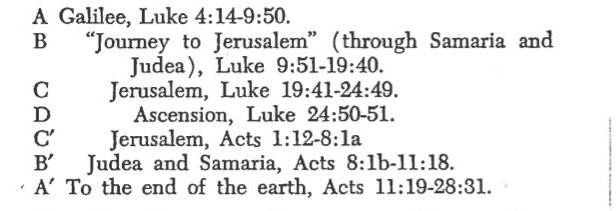By Paxson Jeancake
The Heavenly Arrival
In the Gospel of Luke and in the Book of Acts, we can read of Jesus’ earthly departure. Luke recounts this event twice. Psalm 24, however, offers us a prophetic window into his heavenly arrival.
“Lift up your heads, O gates!
And be lifted up, O ancient doors,
that the King of glory may come in.
Who is this King of glory?
The Lord, strong and mighty,
the Lord, mighty in battle!
Lift up your heads, O gates!
And lift them up, O ancient doors,
that the King of glory may come in.
Who is this King of glory?
The Lord of hosts,
he is the King of glory!” (Psalm 24:7-10, ESV)
Though King David may have written this psalm on the occasion of moving the Ark of the Covenant into Jerusalem, we can stand on the shoulders of the apostles and interpret this, ultimately, as the coronation ceremony of Jesus as he ascended to heaven and took his place at the right hand of the Father.
The Apostolic Precedent for Interpreting the Psalms
As we learned through Peter’s sermon on the day of Pentecost, David, in Psalm 16, “was looking into the future and speaking of the Messiah’s resurrection” (Acts 2:31). We also know that David was speaking of Christ’s ascension in Psalm 110. The apostles likely gleaned this knowledge from Jesus when he said “everything written about me in the law of Moses, the prophets, and the psalms must be fulfilled,” and then “opened their minds to understand the scriptures” (Luke 24:44-45). For more on this topic, refer to my previous article, On the Centrality of the Ascension in Luke-Acts.
We can use the precedent of Peter’s own apostolic commentary on Psalm 16 and Psalm 110 and deduce that, with regard to Psalm 24, David was (most likely) looking into the future and speaking of Christs’s ascension.
An Ascension Sermon for Easter Sunday
To deepen his congregation’s understanding of the resurrection, pastor Brad Allison preached on the ascension of Christ in his Easter sermon in 2018. Using Psalm 24 as his text, he writes:
“Psalm 24 is commonly regarded as a psalm about the ascension of Christ into heaven, mostly because of the last four verses… verses 7-10 tell us something no human has witnessed - the arrival of Jesus in heaven after his resurrection. We have abundant eyewitness testimony to the birth, life, death, and resurrection of Jesus. You can read those eyewitness testimonies in the four Gospels. We also have eyewitness testimony to Jesus’ ascension into heaven. Luke tells us that the apostles all saw Jesus ascend (Acts 1:9). But none of them, nor any other human, witnessed his arrival in heaven.”
It is worth pausing at this moment. “But none of them, nor any other human, witnessed his arrival in heaven.” Have you ever considered Christ’s ascension from earth as his arrival in heaven? Have you ever really used an informed imagination, based on the relevant writings in Scripture, to comprehend the nature of this amazing moment in redemptive history?
The event of the ascension certainly warrants the exercise of our imaginations, but it is also vitally important that we understand the nature of the ascension for it has profound implications on how we understand other doctrines of our faith. Before we expound on those doctrines, let me recount my own journey with regard to Psalm 24 and the ascension of Christ.
My Own Journey in Understanding the Significance of the Ascension
I can still remember the moment, in 2005, that I became acutely aware of my lack of knowledge regarding the ascension of Christ. I had left our home in Atlanta and was driving to the church for a typical day of work. On my drive, a lyric and melody began to “sing” in my mind: “To the King of glory, strong and might. Lord so holy, King of glory.” I couldn’t get to the church fast enough to write down the lyrics and capture the melody so that I didn’t forget it!
In 101 More Hymn Stories, Kenneth Osbeck shares the story behind Helen Lemmel’s hymn, “Turn Your Eyes Upon Jesus.” Here is how Helen describes her moment of inspiration: “I stood still, and singing in my soul and spirit was the chorus, with not one conscious moment of putting word to word to make rhyme, or note to note to make melody.”
My experience with the chorus to our song “King of Glory” was the same as Helen’s experience with “Turn Your Eyes Upon Jesus.” I don’t remember a conscious moment of putting word to word to make rhyme, or note to note to make melody. The text and tune just began to “sing” together in my mind.
As I began to craft the song in my church office, I took a book off my shelf that one of our elders had given to me as a gift. The book was Christ in the Psalms by Patrick Reardon. I turned to his commentary on Psalm 24 and read the words that have literally captured my heart and mind for more than fifteen years.
“Relative to the Lord’s Ascension, we may say that the Church saw Him “going” (Luke 24:51; Acts 1:9) but not “arriving.” That triumphant arrival in heaven, nonetheless - Jesus’ crowning as “Lord of all” - is explicitly affirmed in the New Testament (cf. Mark 16:19; Phil. 2:9; 1 Tim. 3:16).”
Until that moment, I had never given much thought to the event of the ascension. I knew all about Christ’s birth, life, death, resurrection, and return. However, his ascension wasn’t really on my radar, except when we would recite one of the creeds and proclaim: “The third day he rose again. He ascended into heaven and is seated at the right hand of God the Father Almighty.” I imagine this has been your experience as well, and this is precisely why I have felt compelled to write songs, blogs, and articles on this vital aspect of our faith.
Implications for Other Doctrines of Our Faith
I mentioned above that the ascension has profound implications for other doctrines of our faith. Let me explain that statement. Understanding the ascension sheds light on our Christology (doctrine of Christ), our pneumatology (doctrine of the Holy Spirit), our ecclesiology (doctrine of the Church), and our eschatology (doctrine of last things), including our understanding of the present realm of heaven.
These considerations will become more clear in subsequent writings, but for now I will say that a robust doctrine of the ascension helps us understand that Christ is located in a real place called heaven, thus informing our eschatology and what is known as the “intermediate state.” He is still incarnate, in other words, he is still in a physical, though glorified body; and he is still ministering to us from the right hand of the Father, though not physically present with us on earth. Both of these realities inform our view of Christology.
Finally, the Holy Spirit is Christ’s spiritual presence with us on earth, thus informing our pneumatology; and the Spirit is present with us individually as believers and corporately as his Church, thus informing our ecclesiology, our doctrine of the church. This is a brief sketch of what we will unpack in subsequent blog posts, but hopefully it is enough to demonstrate how Christ’s ascension informs other key beliefs and areas of theology.
Cultivating an “Ascended Christ” Consciousness
In this final section I will outline why I believe the ascension suffers such neglect in the church today and offer a way forward. First, its suffers neglect because it is not being celebrated as a major festival in the Christian Year like Christmas and Easter. Second, and related, it is not being preached from pulpits in most churches today. As a result, we don’t really have an “ascended Christ” consciousness. We don’t think of Jesus as the ascended Jesus so much. We have a "virgin-born Christ” consciousness, a “crucified Christ” consciousness, and a “resurrected Christ” consciousness. We can picture him in the manger and on the cross, and we can picture the empty tomb, but we don’t typically think of Christ ascending. Here, I believe, is where Psalm 24 can be of great help to us.
I believe that a big reason we don’t think of Christ ascending is we only have his earthly departure in mind. In other words, we can, at best, only picture the eleven disciples with their necks craned backwards, looking up into the sky. That picture, alone, doesn’t seem too powerful, and may be part of the reason why the ascension is overlooked and neglected.
However, when I consider the ascension from the perspective of Psalm 24, as a coronation ceremony for his heavenly arrival, that stirs my heart and my imagination! This is the perspective I think we need when we think of the ascension of Christ. When we put Luke (Luke 24:51; Acts 1:9) and David’s (Psalm 24:7-10) narratives together, then we can fill out the story of both departure and arrival.
Reflections on the Son’s Return to the Father
Concerning Psalm 24, Justin Martyr (an early Christian apologist) wrote in his Dialogue with Trypho:
“When our Christ rose from the dead and ascended to heaven, the rulers in heaven, under appointment of God, are commanded to open the gates of heaven, that He who is King of glory may enter in, and having ascended, may sit on the right hand of the Father until He makes the enemies His footstool… For when the rulers of heaven saw Him of uncomely and dishonoured appearance, and inglorious not recognising Him, they inquired, ‘Who is this King of glory?’ And the Holy Spirt… answers them, ‘The Lord of hosts, He is this King of glory.’”
Commenting on Justin’s reflections, Dawson writes:
“Justin did not envision the ascension as an instantaneous translation from earth to the right hand of the Father, but rather as a procession that led to the gates of heaven, where angelic sentinels guarded the way to the precincts of God’s presence. Jesus arrived with ‘uncomely and dishonoured appearance,’ caused by his taking up of our humanity and by his passion. Thus still arrayed in our flesh, he was unrecognized by the watchers. Their enquiry, however, was answered by the Holy Spirit, who declared that the still incarnate Jesus is indeed the Lord, the King of Glory.” (Dawson, Jesus Ascended, pg. 61-62).
When we begin to understand Jesus’ ascension in this manner, as a coronation ceremony in the courts of heaven, I believe we will gain a fresh perspective on this neglected event in the life of Christ. I believe that our hearts will soar with awe and wonder at his heavenly arrival as they do at his birth in a manger, his death on a cross, and his resurrection on the third day.
In closing, I will share a final insight regarding Psalm 24 and the ascension of Christ. Inspired by the parable of the Prodigal Son (Luke 15:11-32) and Rembrandt’s painting of that same parable, Henri Nouwen wrote a book titled The Return of the Prodigal Son. In his book, Nouwen meditates deeply on the parable and the painting, wondering if Jesus is the prodigal son who, after lavishly giving himself for the sake of the world, returned to the Father. He writes:
“I am touching here the mystery that Jesus himself became the prodigal son for our sake. He left the house of his heavenly Father, came to a foreign country, gave away all that he had, and returned through his cross to his Father’s home. All of this he did, not as a rebellious son, but as the obedient son, sent out to bring home all the lost children of God… Isn’t the broken young man kneeling before his father the ‘lamb of God that takes away the sin of the world’? Isn’t he the innocent one who became sin for us? Isn’t he the one who didn’t ‘cling to his equality with God,’ but ‘became as human beings are’? Isn’t he the sinless Son of God who cried out on the cross: ‘My God, my God, why have you forsaken me?’ Jesus is the prodigal son of the prodigal Father who gave away everything the Father had entrusted to him so that I could become like him and return with him to his Father’s home… Looking again at Rembrandt’s Prodigal Son, I see him now in a new way. I see him as Jesus returning to his Father and my Father, his God and my God.”
I appreciate Nouwen’s reflections and the way he captures the extravagancy of Christ’s love for us. Jesus gave his life for us and through his death, resurrection, and ascension, we can now have a relationship with him. The one who returned to the Father, opened the way for us as well. In his letter to the Ephesians, the apostle Paul affirms this promise:
“But God, being rich in mercy, because of the great love with which he loved us, even when we were dead in our trespasses, made us alive together with Christ—by grace you have been saved— and raised us up with him and seated us with him in the heavenly places in Christ Jesus” (Ephesians 2:4-6, ESV).
The Belgic Confession also states:
“We have our own flesh in heaven - a guarantee that Christ our head will take us, his members, to himself in heaven.”
These are rich promises for us! Jesus is our forerunner who, right now, is ruling, reigning, and interceding on our behalf at the right hand of the Father. My prayer for the church is that, together, we will be enlivened and enriched as we drink deeply of the event and implications of Christ’s ascension to heaven.











